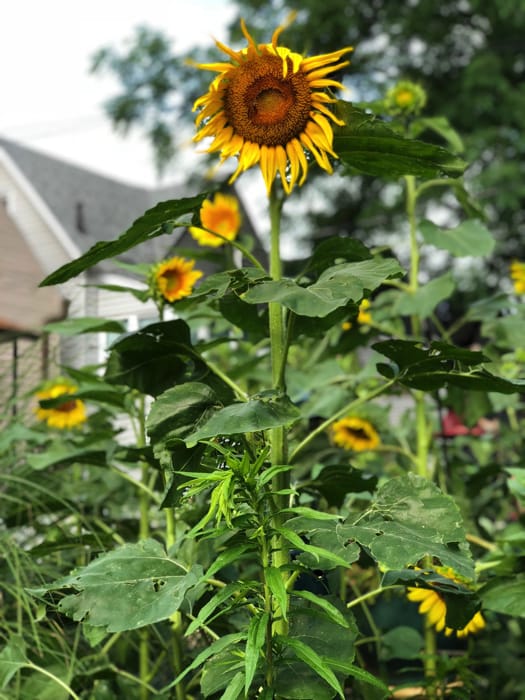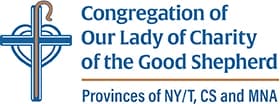Sunflowers captivated Saint Mary Euphrasia. What do you suppose it is about sunflowers that cast such a magical spell over the founder of Sisters of the Good Shepherd?
I like to think that there was more to the story than recognizing the sunflower’s compass-like instinct to turn toward the sun. Rather, I like to imagine that Saint Mary Euphrasia loved nature. And that this is why she came up with the analogy to sunflowers in the first place.
It’s nice to think that she was attracted to sunflowers for their unique proclivity to turn toward the sun. It’s more fun to imagine that she loved sunflowers because they are bright and cheery flowers. And because they draw songbirds and pollinators to a bountiful seed buffet for their survival.
Ultimately, I gain pleasure in pondering St. Mary Euphrasia as a nature girl who found the same delights in nature that I do today. It’s not a hard stretch of the imagination, considering she grew up on an island in France. She spent her childhood exploring cliffs, forests and the wide open sea.
Sunflowers: Conferences, Chapter 3
So, having made this connection and to satisfy my curiosity, I went in search of a back-story to analogy about sunflowers. I turned to the new facebook group that Mission Partners Lizzie Cody and Stella Villasenour started last month for people who want to read and discuss St. Mary Euphrasia’s letters.
I posed a question to the group, asking where I could find the reference to St. Mary Euphrasia’s mention of sunflowers. Lizzie responded within half a nano-second. I’m amazed at how much knowledge Lizzie has about our foundress.
She led me to Chapter 3 in the Conferences and Instructions of Saint Mary Euphrasia Pelletier. These conferences are a composite record of spontaneous talks that St. Mary Euphrasia gave on religious authority, poverty, civil life and other topics related to faith, scripture and God.
Here’s what I read about sunflowers in Chapter 3 on page 29:
“Our work is God’s work, he will protect it! Like sunflowers that look towards the sun and as a compass needle seeks the pole, so your minds should always turn to our Lord, to Rome, to the Congregation.”
Hmmm, I wondered. What prompted her to make this reference to sunflowers? I continued reading. Come to find out, St. Mary Euphrasia made other references to nature in Chapter 3. She was obviously inspired by creation. My kind of woman!
Inspired by all of creation
St. Mary Euphrasia had returned to Angers from Rome on April 17, 1838, when she wrote Chapter 3. Listen to this:
“My dear daughters, I cannot express the emotion our Sisters and I felt on entering Rome! As soon as we glimpsed the holy city we knelt and reverently kissed its blessed soil.”
Think about those words: “It’s blessed soil.” How wonderful is that reference to nature? To call the soil blessed. Indeed it is. Soil is the very source of life, the place from which food grows for all living beings on Earth. The place from which streams begin and flow into rivers and oceans.
She writes further, “We will no longer be children blown about by every wind of Doctrine.”
Wind is strong and powerful. When it’s gentle, we call it a breeze. The mention of wind confirms for me that St. Mary Euphrasia had a connection with nature. Inspired by nature, she tapped strategically from it, painting pictures to make salient points.
Other examples of nature’s influence on St. Mary Euphrasia
- “Now, you are all familiar with ivy – a weak plant, which without support cannot stay upright. However, put it near an oak, it clings to it with all its might, grows upwards and never dies. We cling to our great oak. Rome. In that way we shall have strength and support in difficult times.”
- “Be very recollected gathering, crumb by crumb, like little birds, the spiritual nourishment given to you. If one of you should be light, giddy, inattentive, the instructions given will be of no use, one might just as well throw wheat into the river!”
- “… it is impossible that a Religious Congregation should perish so long as it stays faithfully obedient to her diving authority. Should it suffer persecution the Church would protect it as a mother protects a child in danger. If, in certain environments, this tree cannot bear fruit, the Church will transplant it with maternal wisdom.
And, finally, this
“We must pray much, the Lord wants us to ask urgently if we desire answers to prayer; he wants us to be people of work, prayer and sacrifice. We are not to be inert like stagnant water!”
Nature girl
St. Mary Euphrasia was shaped by nature, and in my mind’s eye, fortified by it as well. A love for nature coursed through her veins.
There’s something about remembering this that makes my heart sing. And spurs me onward to keep reading, to keep discovering tidbits about the remarkable woman who left a legacy of overflowing activity that has helped shape our world.
Everyone is welcome to join the facebook group St. Mary Euphrasia Letters Reading Club.

